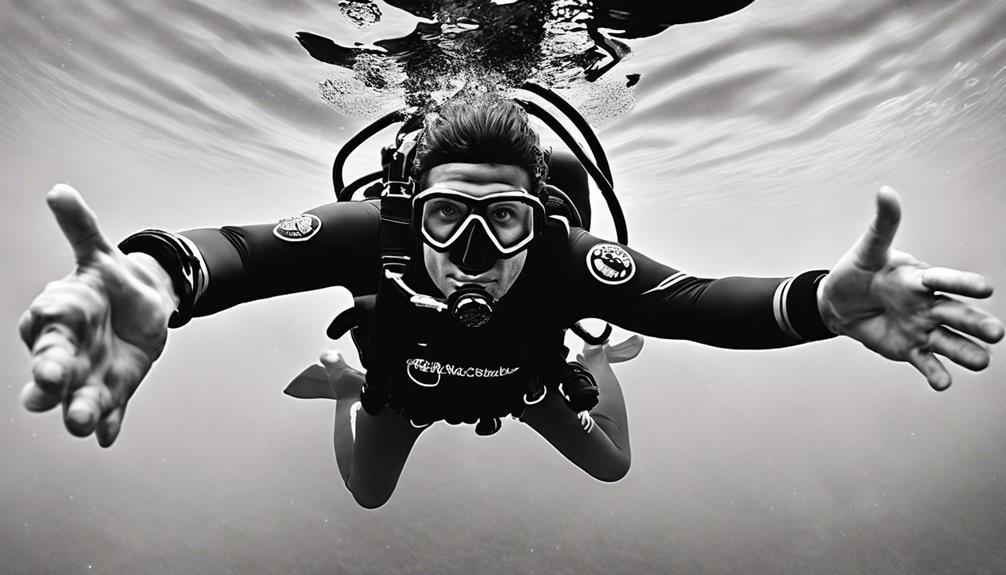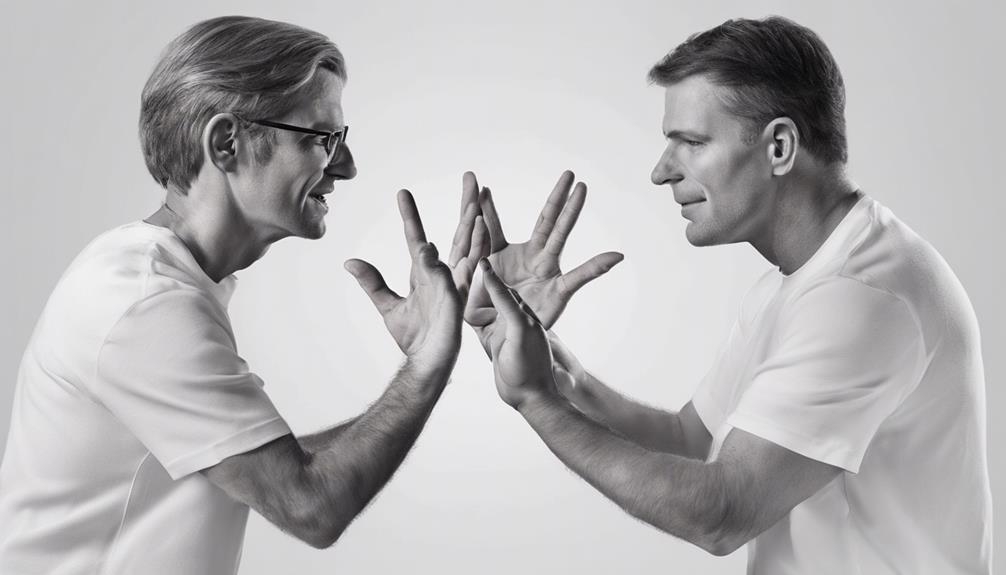Have you ever submerged yourself deep into the ocean’s embrace, surrounded by the enchanting allure of underwater creatures, only to notice the profound silence that comes with it?
Mastering Scuba Diving Sign Language is a subtle art that opens a whole new realm of communication underwater. From basic signals to advanced techniques, this guide offers a structured approach to enhancing your diving experience and safety.
So, if you're curious about how hand signals can transform your underwater adventures, this guide holds the key to unlocking a whole new world beneath the surface.
Key Takeaways
- Learn marine life signals for effective underwater communication.
- Practice basic number signs for depth, time, and air supply.
- Enhance safety with precise depth and emergency signaling techniques.
- Master hand signals for buddy communication and dive safety.
Importance of Scuba Diving Hand Signals
Understanding the significance of scuba diving hand signals is paramount for ensuring effective communication and enhancing diver safety during underwater excursions. These standardized signals serve as the backbone of underwater communication, allowing divers to convey crucial messages with precision. By mastering these hand signals, divers can quickly communicate essential information such as their well-being, potential issues, or emergency situations. Utilizing these signals enhances diving safety by minimizing confusion and ensuring swift responses to varying underwater scenarios.
Divers must grasp the importance of these standardized hand signals to maintain clear communication, especially in low visibility conditions where verbal communication is impractical. Proficiency in these signals facilitates efficient exchanges regarding dive plans, potential hazards, and exciting marine life sightings. Additionally, understanding and adhering to these signals is vital for ensuring effective communication amongst diving buddies and dive leaders. By mastering scuba diving hand signals, divers can navigate the underwater world with confidence, safety, and clarity.
Learning Scuba Diving Hand Signals
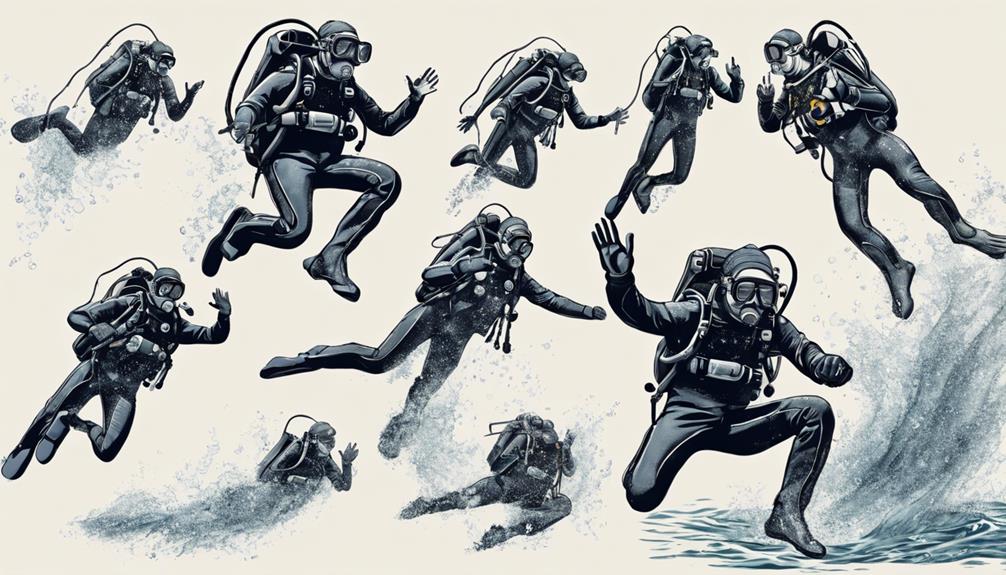
Learning scuba diving hand signals is a fundamental aspect of diver training, ensuring effective communication and safety while exploring underwater environments. Proficiency in using scuba diving hand signals is honed through practice in controlled environments, allowing divers to master a variety of gestures for clear underwater communication. Regular revision of these signals is crucial to maintaining proficiency and ensuring clarity during dives, particularly in challenging scenarios like night dives where visibility is reduced.
Clear and precise hand signals are essential for diver safety, as they convey crucial messages without the need for verbal communication. Mastering scuba diving hand signals not only enhances safety but also contributes to the overall enjoyment of underwater experiences. Divers who are adept at using these signals can quickly and accurately communicate with their buddies, instructors, or other divers, creating a seamless and secure diving environment. Therefore, investing time and effort in learning and mastering scuba diving hand signals is paramount for any diver seeking to explore the depths with confidence.
Basic Scuba Hand Signals
Mastering basic scuba hand signals is crucial for effective underwater communication and diver safety. Common scuba diving hand signals play a vital role in conveying messages to your dive buddy without the need for verbal communication. Here are some essential signals every diver should know:
- Signaling 'OK': Raise a hand with thumb and index finger forming a circle.
- Signaling a problem: Extend your hand with palm down, spread fingers, and rotate your hand side to side.
- Signaling 'stop': Extend your arm with the palm facing out and raise a finger.
- Signaling 'up' and 'down': Form a fist with the thumb extended up for 'up', and point the thumb downward for 'down'.
These basic scuba hand signals are fundamental for navigating underwater scenarios efficiently and ensuring diver safety.
In emergency scuba situations, like running out of air, knowing and using these signals promptly can make a crucial difference in resolving issues swiftly and effectively.
Advanced Communication Techniques
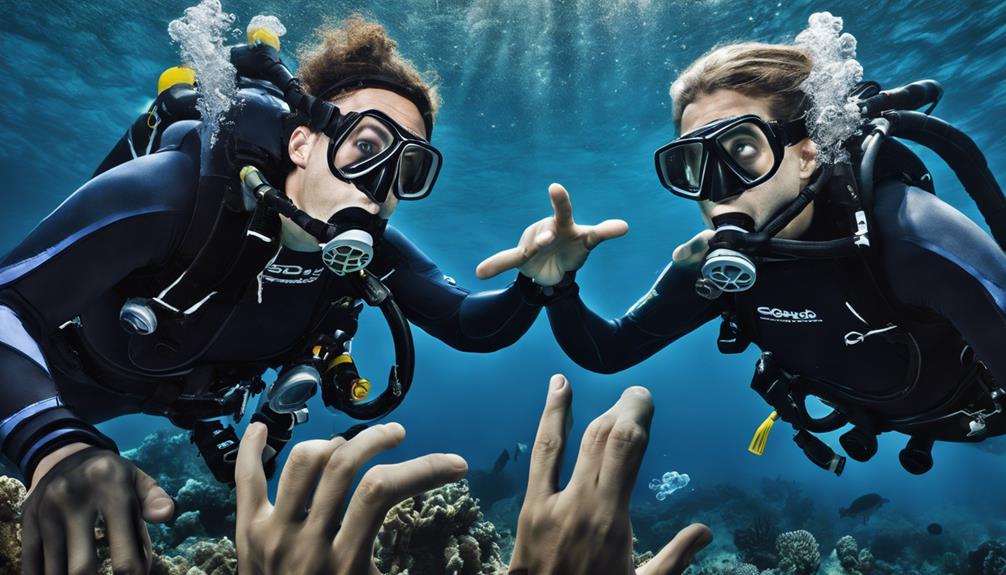
When we explore advanced communication techniques in scuba diving, one important aspect involves mastering hand signals for depth and non-verbal emergency responses. These signals allow divers to convey specific numerical information and respond efficiently to urgent situations without verbal communication.
Customizing signals based on individual preferences and dive team requirements further enhances the effectiveness of underwater communication.
Hand Signals for Depth
Utilizing advanced hand signals for depth in scuba diving requires precise coordination and clear communication between divers. When signaling depth underwater, it's crucial to convey accurate information to ensure the safety of all individuals involved.
To master depth communication techniques effectively, divers should consider the following:
- Arm Extension: Use one arm with fingers bunched up and thumb pointing down for descent or up for ascent.
- Importance: Essential for controlled ascents and descents to prevent barotrauma and decompression sickness.
- Precision: Accurate communication ensures proper depth levels for safety and decompression stops.
- Practice: Regular drills in controlled environments help divers refine their depth signaling skills.
Non-Verbal Emergency Responses
In scuba diving, mastering non-verbal emergency responses through advanced communication techniques is essential for ensuring diver safety in critical underwater situations. Divers rely on standardized SCUBA HAND SIGNS to communicate distress, out-of-air situations, and other emergencies effectively. These signals, taught in advanced scuba diving courses, facilitate quick and clear communication during crises, reducing the risk of misunderstandings or delays in assistance. The table below illustrates some essential SCUBA HAND SIGNS for emergency responses:
| Situation | SCUBA HAND SIGNS | Meaning |
|---|---|---|
| Out of Air | Hand to throat | Low on air, need to ascend |
| Distress | Waving arms | Need immediate assistance |
| OK | Thumb and index OK | Signal that everything is fine |
| Emergency Ascent | Hand flat, palm up | Initiate emergency ascent to the surface |
Practice and familiarity with these hand signals are critical for all divers to respond promptly and effectively in emergency scenarios.
Signaling Emergency Situations
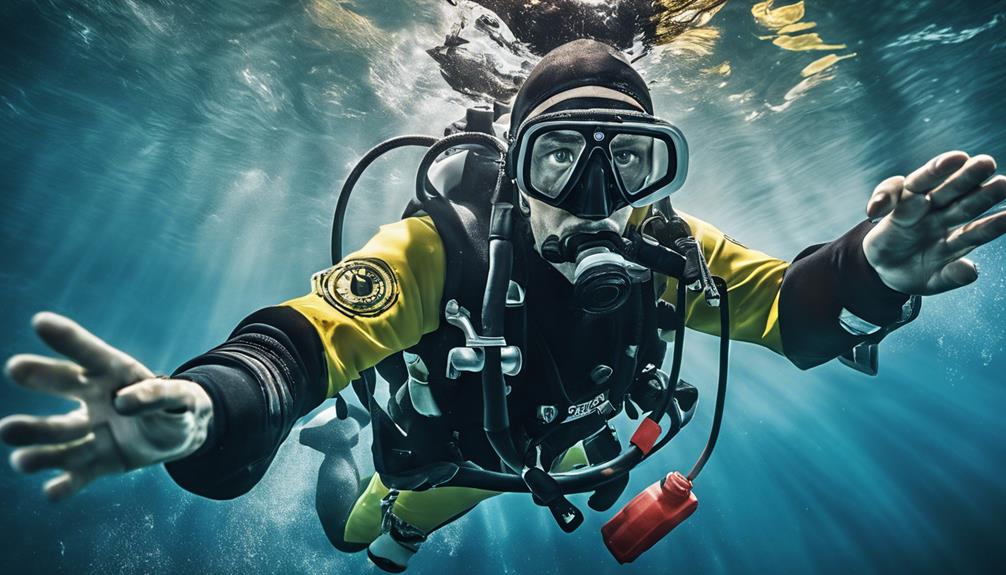
Signaling emergency situations underwater requires precise and swift communication through a set of designated hand signals. Mastering emergency scuba diving hand signals is essential for ensuring safety and effective communication during dives.
Here are some key emergency signals to be familiar with:
- Out-of-Air Sign: This signal involves a motion across the throat to indicate a low or empty air supply. It's crucial for alerting your dive buddy or dive group that you're running out of air.
- Sharing Air Signal: To communicate the need to share air with a buddy, signal by moving your open palm toward your mouth, indicating the action of breathing from a shared alternate air source.
- Danger Sign: In situations where there's perceived danger, extend your arm, make a closed fist, and point at the threat to alert others. This signal is vital for drawing attention to potential hazards and ensuring swift responses.
- Effective Communication: Practice these emergency signals regularly to ensure quick and accurate communication, promoting safety and preparedness in emergency situations.
Hand Signals for Marine Life
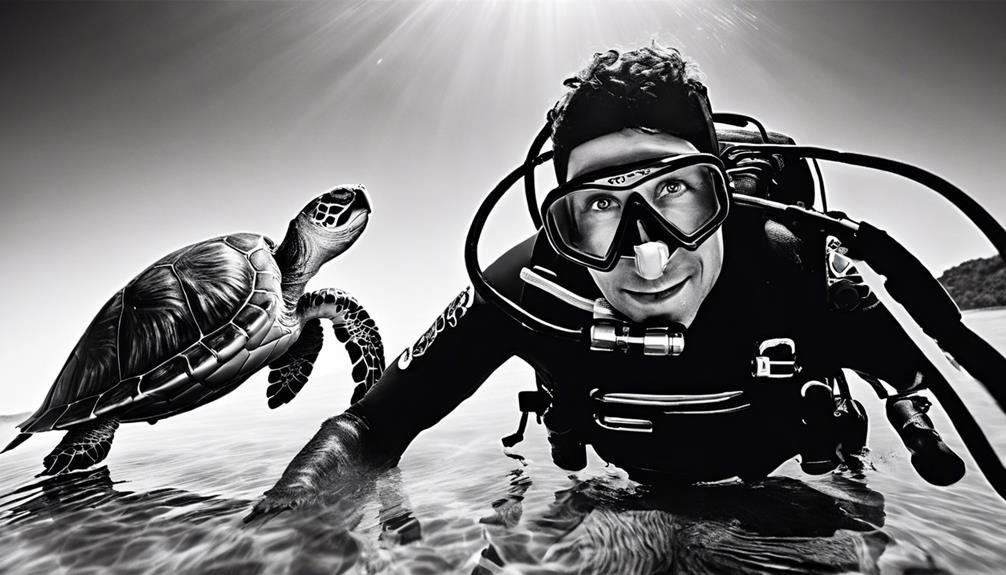
When encountering marine life during scuba dives, understanding and using specific hand signals is crucial for effective communication and interaction. Marine life signals are essential tools for scuba divers to communicate sightings and ensure safety underwater.
For instance, the universal shark signal involves extending your palm to your forehead to indicate a shark sighting. It's vital to learn and practice these signals to communicate effectively with dive buddies and guides.
Regional variations in marine life signals exist, so familiarizing yourself with these variations can enhance your communication skills. Practice using signals for various marine species such as mantas, turtles, and stonefish to broaden your underwater communication repertoire.
Before diving in different locations, make sure to acquaint yourself with the local hand signals for marine life to facilitate seamless communication with fellow divers and dive professionals. Mastering these specific hand signals won't only enrich your underwater experience but also promote a deeper connection with marine creatures.
Mastering Number Signaling
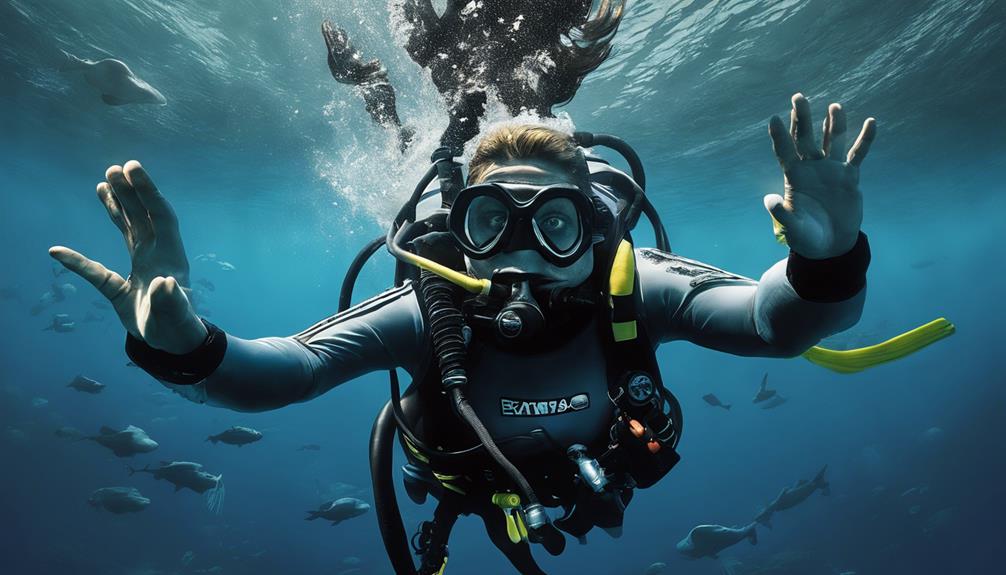
When it comes to mastering number signaling in scuba diving, it's crucial to understand the basic number signs and advance into more complex signaling techniques.
By using clear and precise hand signals, divers can communicate specific numerical values such as depths, air supply levels, and time durations effectively underwater.
Developing proficiency in number signaling enhances safety, efficiency, and coordination among diving partners, ultimately contributing to a smoother and more enjoyable diving experience.
Basic Number Signs
Understanding the basic number signs in scuba diving hand signals is crucial for effectively communicating numerical information underwater. When signaling numbers, precise gestures are key to conveying accurate details to your dive buddy. Here are some essential points to remember:
- Utilize fingers and hand configurations to represent numbers clearly.
- Practice consistency in your number signaling to avoid confusion.
- Remember that different diving organizations may have slight variations in number signs.
- Ensure you understand common numerical references like remaining air supply, dive times, and depth measurements.
Mastering these basic number signs will significantly enhance your ability to communicate vital information during dives, promoting safety and efficiency in your underwater experiences.
Advanced Signaling Techniques
Mastering number signaling in scuba diving requires precise hand signals to effectively convey specific numerical values underwater. Divers use these scuba signals to communicate crucial information such as depths, time, and air supply levels during dives.
Advanced signaling techniques play a vital role in diver training, emphasizing the importance of clear and accurate communication underwater. Diving instructors often focus on teaching divers how to customize number signals based on individual preferences or specific diving conditions.
Understanding and mastering these advanced techniques not only enhance diver safety but also contribute to efficient dive planning and execution. By incorporating advanced number signaling into regular dive practices, divers can significantly improve their overall diving experience and readiness for various underwater scenarios.
Enhancing Buddy Communication
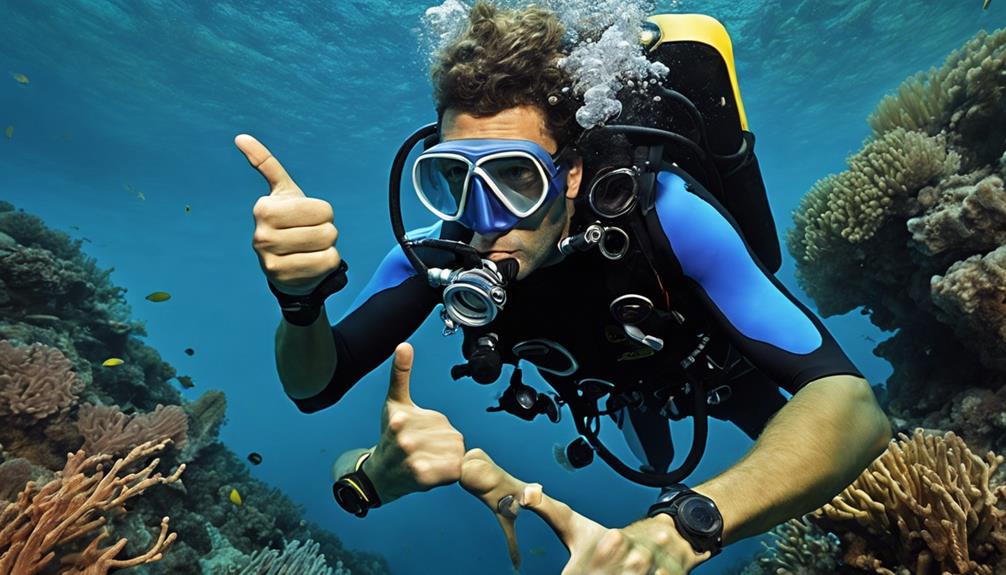
To enhance buddy communication underwater, divers should consistently practice and reinforce key signals such as 'Buddy Up,' 'Stay Close,' and 'Follow Me' to ensure effective teamwork and safety. Clear and concise communication between dive buddies is paramount for a successful and safe diving experience. Here are some essential tips to enhance buddy communication:
- Establish Clear Signals: Ensure that both you and your buddy understand and agree upon the signals to be used before the dive.
- Maintain Visual Contact: Regularly check on your buddy's position and communicate through gestures to stay connected.
- Practice Emergency Signals: Familiarize yourselves with emergency signals like 'Out of Air' or 'Help Me' to react swiftly in critical situations.
- Debrief After Dives: Discuss the effectiveness of your communication post-dive to identify areas for improvement and strengthen your underwater bond.
Using Hand Signals for Safety
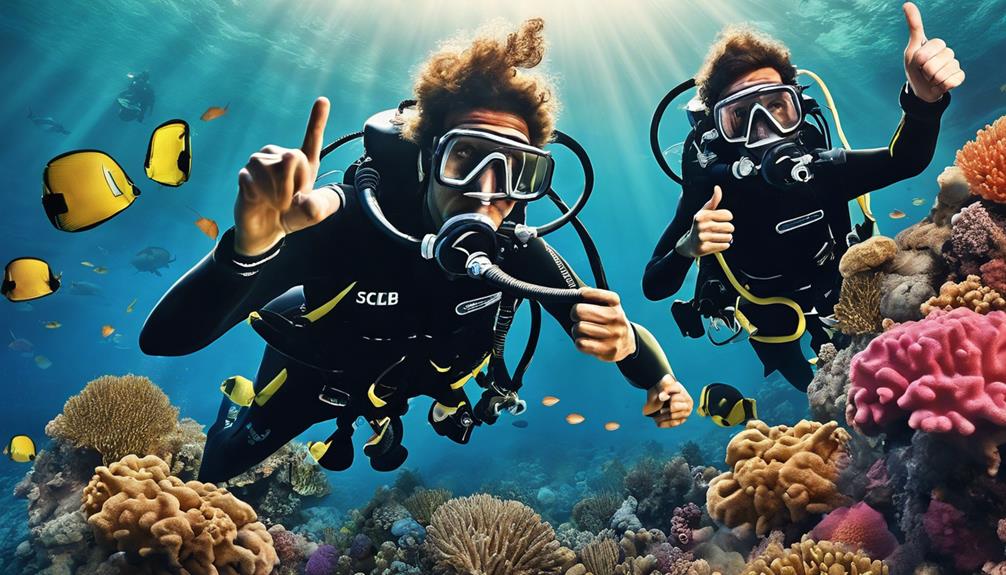
Establishing clear and standardized hand signals is crucial for ensuring diver safety and effective communication underwater. When scuba diving, using hand signals for safety plays a vital role in preventing accidents and addressing emergencies promptly. Below is a table illustrating some common hand signals used in scuba diving for safety:
| Hand Signal | Meaning | Importance |
|---|---|---|
| OK | Are you okay? | Vital for continuous communication |
| Stop | Halt or pause | Essential for immediate action |
| Out of Air | I am out of air | Critical for addressing air supply issues |
Mastering these hand signals is essential for all divers to ensure effective communication and safe diving practices. Practicing these signals in controlled settings enhances diver safety and readiness for real-life underwater situations. By utilizing standardized scuba diving hand signals, the risk of misunderstandings decreases, enabling clear communication even in low visibility conditions.
Frequently Asked Questions
Do Scuba Divers Learn Sign Language?
Yes, scuba divers learn a specialized set of hand signals for underwater communication. These signals are crucial for safety and effective communication during dives.
While scuba divers don't learn traditional sign language, they do acquire specific diving signals as part of their training. Mastering scuba diving hand signals enhances diver coordination and safety underwater, making it a fundamental skill for all divers.
What Are the Four E's of Diving?
When diving, the Four E's — Equipment, Environment, Education, and Experience — are crucial. Proper gear (Equipment), awareness of surroundings (Environment), continuous learning (Education), and practice (Experience) form the foundation of safe and enjoyable dives.
Adhering to these principles fosters competence, confidence, and a profound connection to the underwater world. Mastering the Four E's ensures a deeper appreciation and understanding of the aquatic realm.
How to Scuba Dive Step by Step?
When scuba diving, we follow a step-by-step process for a safe and enjoyable experience.
First, we conduct pre-dive safety checks to ensure equipment readiness.
Then, we enter the water using proper techniques.
During the dive, we maintain proper buoyancy, monitor air supply, and communicate effectively using hand signals.
Finally, we ascend slowly and complete post-dive checks.
This systematic approach ensures a successful scuba diving adventure.
What Is ABCD in Diving?
ABCD in diving is like a compass guiding us through emergencies. It stands for:
- Airway
- Breathing
- Circulation
- Disability assessment
This systematic method helps us evaluate a diver's condition swiftly and effectively, identifying and responding to potential diving-related issues.
It's crucial for diver safety and well-being during emergencies, used by divers, dive professionals, and medical personnel for proper care and management.
Conclusion
In conclusion, mastering scuba diving sign language is essential for effective communication underwater. By learning and practicing hand signals, divers can ensure safety, understanding, and enjoyment during dives.
Clear and precise communication is key to a successful dive experience, creating a common language among divers and enhancing overall safety.
So, remember to hone your skills in scuba diving sign language to truly immerse yourself in the underwater world.

